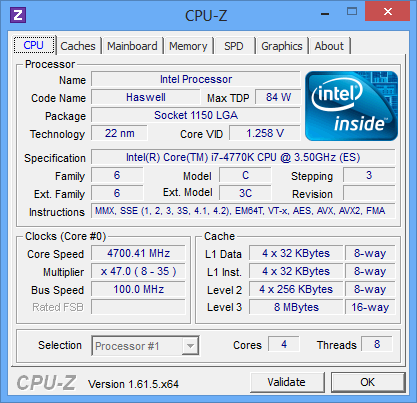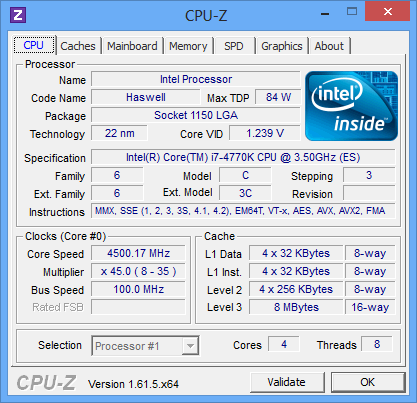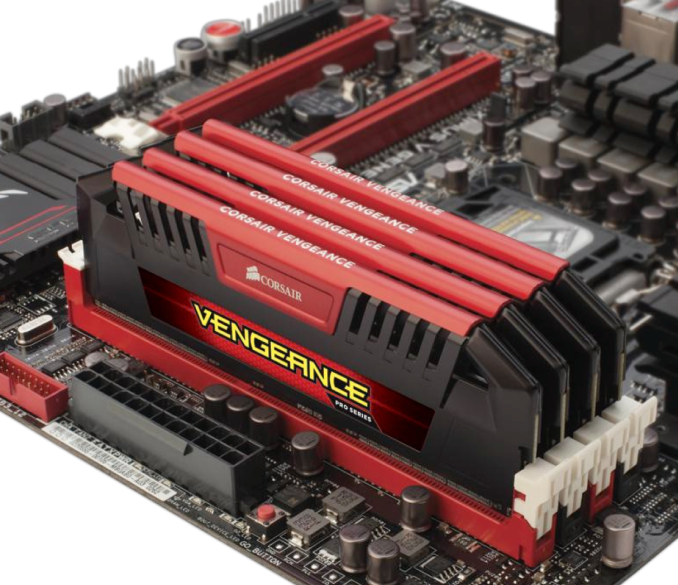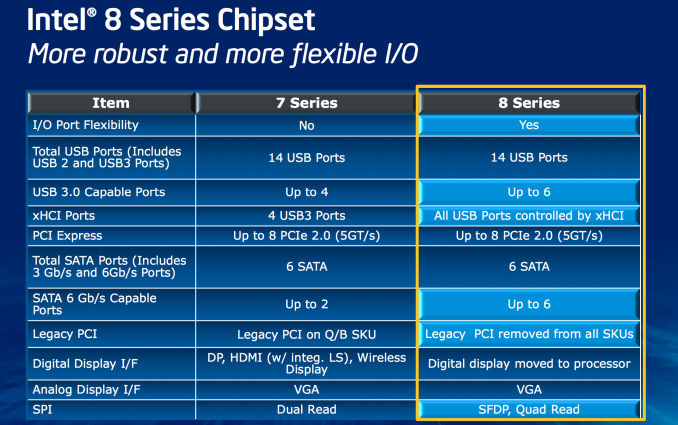The Haswell Review: Intel Core i7-4770K & i5-4670K Tested
by Anand Lal Shimpi on June 1, 2013 10:00 AM ESTMemory
Haswell got an updated memory controller that’s supposed to do a great job of running at very high frequencies. Corsair was kind enough to send over some of its Vengeance Pro memory with factory DDR3-2400 XMP profiles. I have to say, the experience was quite possibly the simplest memory overclocking I’ve ever encountered. Ivy Bridge was pretty decent at higher speeds, but Haswell is a different beast entirely.
Although I used DDR3-2400 for most of my testing, Corsair’s Vengeance Pro line is available in frequencies rated all the way up to 2933MHz.
Platform
Haswell features a new socket (LGA-1150). Fundamental changes to power delivery made it impossible to maintain backwards compatibility with existing LGA-1155 sockets. Alongside the new socket comes Intel’s new 8-series chipsets.
At a high level the 8-series chipsets bring support for up to six SATA 6Gbps and USB 3.0. It’s taken Intel far too long to move beyond two 6Gbps SATA ports, so this is a welcome change. With 8-series Intel also finally got rid of legacy PCI support.
Overclocking
Despite most of the voltage regulation being moved on-package, motherboards still expose all of the same voltage controls that you’re used to from previous platforms. Haswell’s FIVR does increase the thermal footprint of the chip itself, which is why TDPs went up from 77W to 84W at the high-end for LGA-1150 SKUs. Combine higher temperatures under the heatspreader with a more mobile focused chip design, and overclocking is going to depend on yield and luck of the draw more than it has in the past.
Haswell doesn’t change the overclocking limits put in place with Sandy Bridge. All CPUs are frequency locked, however K-series parts ship fully unlocked. A new addition is the ability to adjust BCLK to one of three pre-defined straps (100/125/167MHz). The BCLK adjustment gives you a little more flexibility when overclocking, but you still need a K-SKU to take advantage of the options.


In terms of overclocking success on standard air cooling you should expect anywhere from 4.3GHz - 4.7GHz at somewhere in the 1.2 - 1.35V range. At the higher end of that spectrum you need to be sure to invest in a good cooler as you’re more likely to bump into thermal limits if you’re running on stable settings.

















210 Comments
View All Comments
smoohta - Saturday, June 1, 2013 - link
Blah, seems like a rather shallow review:1. What about benchmarks to take advantage of the new AVX2 instructions? (FMA specifically would be interesting)
2. Same for TSX?
Klimax - Sunday, June 2, 2013 - link
I know only about x264 having it in the last versions. Not sure who else has it.Gigaplex - Saturday, June 1, 2013 - link
"Here I’m showing an 11.8% increase in power consumption, and in this particular test the Core i7-4770K is 13% faster than the i7-3770K. Power consumption goes up, but so does performance per watt."So... performance per watt increased by ~1%. For a completely new architecture that's supposedly all about power optimisation, that's extremely underwhelming to say the least.
Homeles - Saturday, June 1, 2013 - link
Haswell is not focusing on the desktop I'm not sure how you managed to believe that it is.krumme - Saturday, June 1, 2013 - link
Because Anand is a fan of it, even at desktop?MatthiasP - Saturday, June 1, 2013 - link
So we get +10% performance increase for +10% increase in energy consumption? That's rather disappointing for a new generation.jeffkibuule - Saturday, June 1, 2013 - link
Haswell is movinig voltage regulators that were already on the motherboard on die, so power consumption hasn't changed, it's just that the CPU cooling system has to deal with that extra heat now. Remember that those power ratings are NOT about how much power the chip uses, but how much cooling is needed.Homeles - Saturday, June 1, 2013 - link
System power consumption with Haswell is, in fact, higher. Take a look at page 2.Still, when you're running at these kind of frequencies, 10% more performance for 10% more power is a big deal. If you were to hold back the performance gains to 0%, power savings would be greater than 25%.
The only reason Piledriver was able to avoid this was because it was improving on something that was already so broken. AMD's not immune to the laws of physics -- when they catch up to Intel, they will hit the same wall.
Klimax - Sunday, June 2, 2013 - link
Most likely sooner, because they can't fine tune process.dgz - Saturday, June 1, 2013 - link
I agree but Intel has been doing that for many years. I just don't get what they're gaining by artificially restricting IOMMU support.